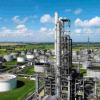Hello, all. This is my first post after having lurked and benefited from y'all's excellent knowledge for a while now. I'm a chemical engineer with 5 years experience in a small engineering and fabrication company that builds a wide variety of small gas and crude processing plants, among other things. Those 5 years have netted me hands-on design experience in just about every facet of engineering that goes into plants. I try to learn as much as possible about something, even if it's not within my official scope as a chemical engineer. Nice to meet everyone.
We're working on a crude topping unit right now, and I'm reviewing the exchangers preheating the feed by crossing with the column products. Since I was on another project when these exchangers were rather hastily designed, I was unable to add any input, despite being the resident heat exchanger guy. U-tubes were chosen for all the exchangers, with the crude on the tubeside. I'm pretty much stuck with this design, so I'm trying to rate it and see if it is indeed viable, needs to be tweaked, or truly needs to be scrapped (not a pleasant idea since some of the shells, though small, have already been built). Tubesheets, tubes, and baffles have not been ordered yet, so I still have a window to make fixes.
I'm stuck on the very first exchanger, however, which is crossing with the gas off the top of the column. The gas is entering at its dewpoint, condensing fully, and then subcooling. The crude is heating sensibly with no phase change. I haven't included the process specifics in this post, because 1) I'm not necessarily looking for a specific discussion of this one exchanger, and 2) since we're talking about crude, I'm not sure what information I should post since it's a complex mixture. Let me know what I should post if we do decide to look at this specific case.
I need to know if there's any way to design/rate this exchanger by hand. At the moment, we do not have HTRI. (I always want to know how to do something by hand anyways as a backup, since I'm wary of these black boxes we call design software). A while back, when we did have HTRI, I was running this exchanger and getting screwy results like pressure drops of hundreds of pounds on the crude side, even though the system pressure never rises above 50 psia. With that, I didn't feel I could trust any of the results. Than, I had to move on to something else back then, so I never got it resolved.
So, here's what I've got:
Shell-and-tube exchanger
1 shell pass (condensing and subcooling gas), 2 tube passes (preheating crude)
All streams are mixtures so condensing takes place over a temperature range.
The overall process design is done in HYSYS, so I can grab whatever stream properties I need from there.
I don't care if it's cumbersome; are there any resources that would tell me how to approach this problem by hand? I'll need to check both heat transfer and pressure drops. Whether it's books (preferably with specific passages or chapters mentioned), articles, or whatever else, I will locate it somehow, once I know what it is I'm looking for. Obviously, there will be some approximations, but even approximations can at least tell me if previous work on this is close or not. Plus, I could use another engineering tool in my arsenal to check the output of these design programs when necessary.
The closest thing I've found is from Ludwig, Vol. 3, 3rd Ed, Example 10-11, "Desuperheating and Condensing Propylene in Shell." It is a two tube-pass exchanger, and he recommends treating the condensing and desuperheating sections in the example separately, then combining their areas. I was going to try that with mine, but HYSYS gave me confusing results. Modeling the exchanger normally (with condensing and subcooling all together) gives me a still-acceptable Ft correction factor of 0.761. Modelling the condensing and subcooling sections as separate exchangers in series gives me an off-the-chart low Ft factor on the subcooling section. Not good, but is it accurate?
I've thought that maybe I could figure this out by solving step-by-step from one end of the exchanger to the other. Unfortunately, even if this is a viable idea, I can't figure out how to do it. I know this is a very complicated problem to do by hand, but I think I can make the right estimates to make it work. I just need the methodology.
Forgive the wall of text with few specifics. I'm just looking for some pointers in the right direction, because I'm stumped at the moment. Just tell me what else I need to provide, and I'll do my best to get it in here. Thank you.
|
|
Hand Calculating A U-Tube Exchanger For Condensing And Subcooling
Started by Keith84, Sep 07 2012 05:04 PM
exchanger subcooling utube twopass condensing
1 reply to this topic
Share this topic:
#1

Posted 07 September 2012 - 05:04 PM
#2

Posted 09 September 2012 - 03:37 PM
Keith84:
I think you are on the right trail. The majority of heat exchangers I've designed (and built) have been based on nothing more than a slide rule + pencil + paper. If you go to Don Q. Kern's famous book, "Process Heat Transfer" (1950). You will see that he dedicates an entire chapter to the type of problem you are confronting. And he follows the theory and explanations with worked examples and further chapters on similar applications.
Go to Kern's Chapter 13 - Condensation of Mixed Vapors (page 313), which I think deals with the topic you have presented. In fact Kern presents a worked for this type of application that uses a 1:2 heat exchanger - which can be applied to a U-Tube type of as well.
I think you are on the right trail. The majority of heat exchangers I've designed (and built) have been based on nothing more than a slide rule + pencil + paper. If you go to Don Q. Kern's famous book, "Process Heat Transfer" (1950). You will see that he dedicates an entire chapter to the type of problem you are confronting. And he follows the theory and explanations with worked examples and further chapters on similar applications.
Go to Kern's Chapter 13 - Condensation of Mixed Vapors (page 313), which I think deals with the topic you have presented. In fact Kern presents a worked for this type of application that uses a 1:2 heat exchanger - which can be applied to a U-Tube type of as well.
Similar Topics
Steam Pressure In Heat ExchangerStarted by Guest_mvanrijnbach_* , 15 Apr 2025 |
|

|
||
Rotated Triangular Tube Layout Vs Triangular Tube LayoutStarted by Guest_Heat Transfer Novice_* , 28 Sep 2024 |
|

|
||
Heat Exchanger Steam FlowStarted by Guest_aliebrahem17_* , 25 Nov 2024 |
|

|
||
Supercritical Fluid Flowrate - He Tube RuptureStarted by Guest_flarewolf_* , 07 Apr 2025 |
|

|
||
Prv Vs Extraction Condensing TurbineStarted by Guest_mj311_* , 13 Nov 2024 |
|

|

 FB
FB








